
Unreal Engine vs Unity: A Comprehensive Comparison for 2026
Unreal Engine vs Unity is one of the choices you’ll have to make when developing a game. Explore what each engine brings to the table.
Continue ReadingDid you know? The workout tracking app market size is expected to grow by USD 101.60 billion at a CAGR of 24.2% between 2025 and 2029.
Gone are the days when staying fit meant spending thousands on gym membership or personal trainers. Now you have a fitness coach right in your pocket. Yes, you heard it right – in the form of a workout-tracking app. These workout-tracking apps will help users to improve their fitness, monitor progress, and keep on track. These fitness apps have now turned the reality of millions who use them to maintain their fitness and wellness.
Among the various fitness tracker apps available in the market, Fitbit stands out as a market leader in activity tracking app. In 2009, Fitbit released its first-ever product to track basic activities like distance traveled, steps taken, and total calories burned. Fitbit completely changes the way we used to look at our fitness and wellness.
If you are looking to make a competitive fitness tracking app, this comprehensive blog will guide you through the core features of a workout-tracking app, how to build a successful workout-tracking app, and understanding Fitbit like app development, We will also look out for the emerging trends in fitness app development for 2025 and monetization opportunities for workout tracking apps.
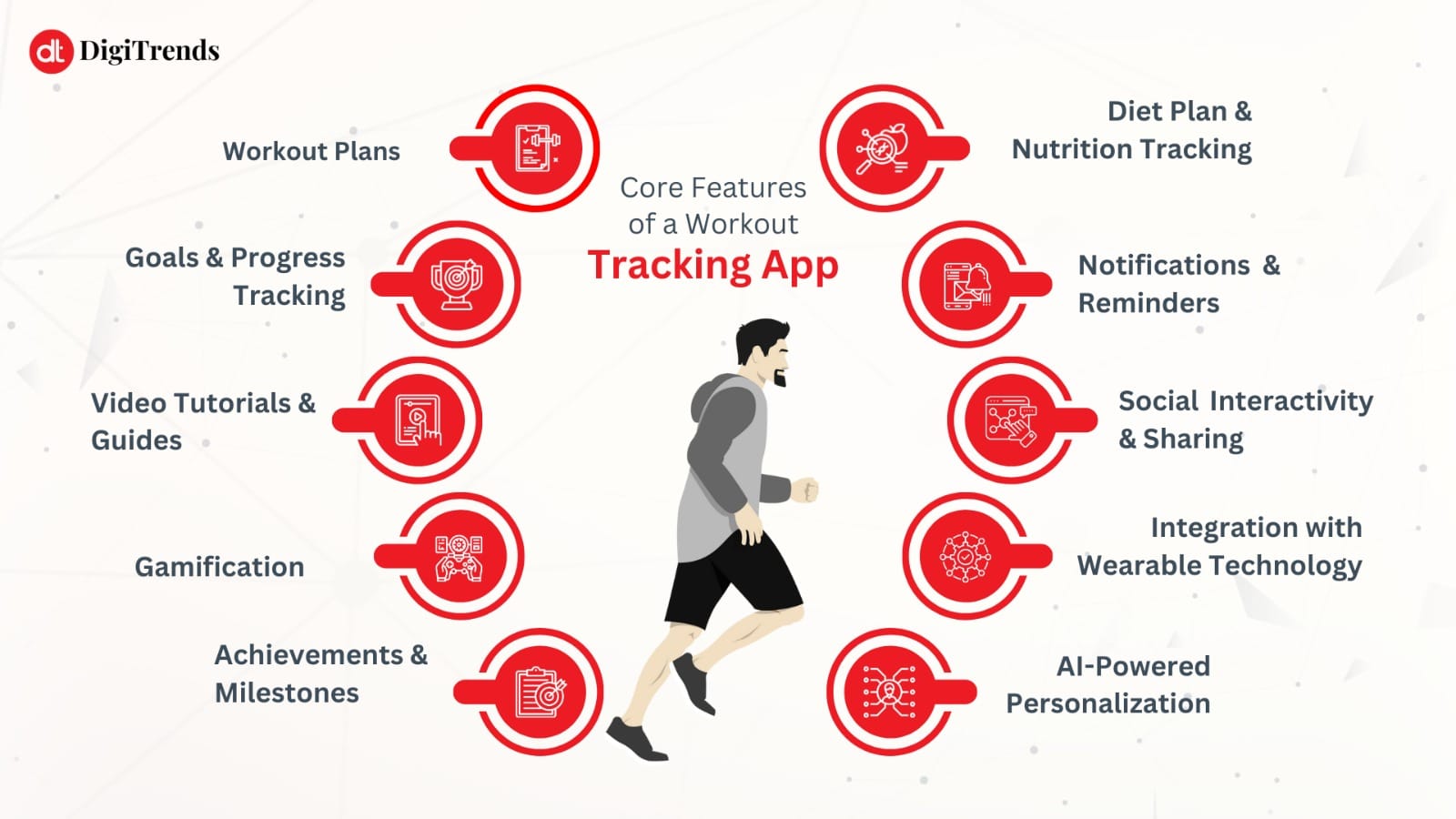
A top tier workout tracking app should offer a variety of workout plans and exercises as per individual needs. A well structured health and fitness app should recommend best workouts based on user goals and categorize workouts by options such as gender, fitness levels, or goals. Moreover, users should be able to see previous sessions before starting a new session to track consistency and progress.
The main objective of health and fitness app is to help users to achieve their goals. Making Goal Setting and Tracking is the most important feature of the workout tracking app because what’s the point of having an app if you cannot track your progress? Add feature of goal setting and tracking where a user can set up fitness goals like losing 5 kg in two months and measure progress through:
Implementing analytics will allow progress to be tracked in a way that tells a user as to whether they are on track. If they are behind, the app can send alerts such as:
We suggest we are losing in achieving your fitness goal Sarah! Log in Now and get back on track.
Hey Sarah! You are falling behind your target. Log in Now (App Name) to get back on track.
For a better user experience, include video tutorials demonstrating exercises with proper form and technique. This feature will be especially helpful for beginners and ensure workouts are performed safely and effectively. Furthermore, users can follow along and maintain motivation more easily with the help of visual clarity that video demonstrations can offer.
Bringing game-like elements into a activity tracking app can make workouts more engaging. Some gamification features to consider:
Fitness apps should give users a feeling of achievement by acknowledging their progress. When they reach important milestones like finishing a 30-day challenge or running their first 5K , celebrate with badges, certificates, or virtual trophies.
A workout plan alone isn’t good enough— you have to eat right before you go right. Your app should include:
Even the most committed fitness enthusiasts need reminders in this busy life. Soo notification is essential in any fitness app, Push notifications to
People enjoy sharing their fitness journey with others on various social media platforms today. Many successful workout tracking app allow user to share their progress on social media, developing a sense of community. Your app should enable users to
This is the time of interconnectivity. Every fitness tracker app you touch now has an easy Sync option. You can connect your smartwatches with smartphones, smart TVs, laptops, etc. Therefore wearable app development is necessary to integrate wearable with non-wearable technology. It may include
These gadgets make the workout apps more engaging for users also they enhances the app usability.
AI can advance fitness app development by using AI. Artificial intelligence can elevate personalization to a new level by evaluating user data and customized recommendations. For instance, AI powered workout tracking apps can:
Fitbit which began as a wearable bracelet in 2007 is now one of the most well-known brands in the fitness trackers apps. By focusing on continuous innovation, Fitbit app development, the company has introduced innovative features such as sleep tracking, heart rate monitoring and AI driven workout recommendations which set it apart from competitors.
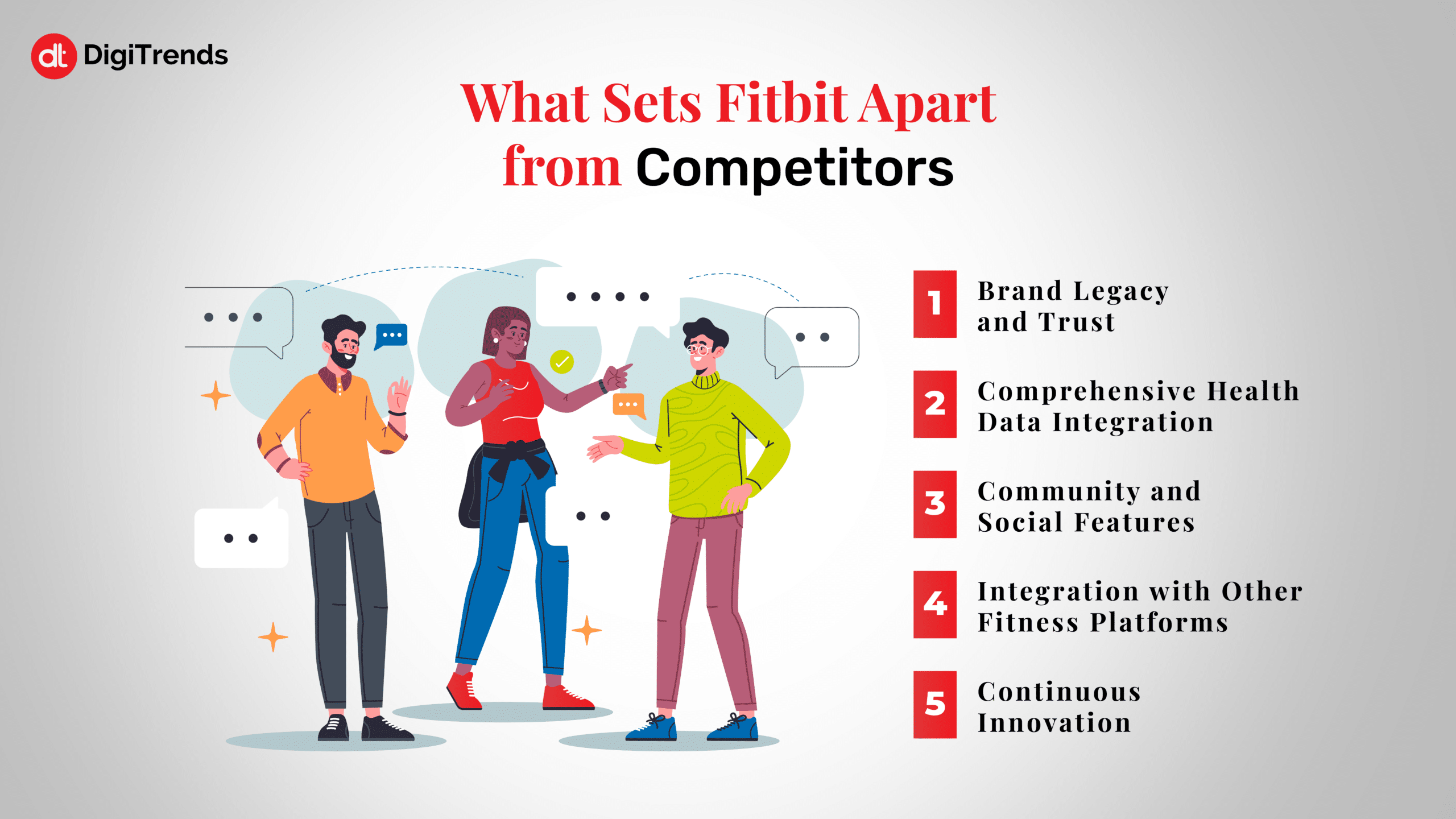
Fitbit had an advantage in building a strong brand identity in activity tracking app development because it was one of the first companies to release wearable fitness trackers.
Fitbit has gained millions of customers’ trust over the years with its reliable high quality products. The company’s well-established reputation is a result of its long history in the industry.
From basic fitness trackers to advanced smartwatches, Fitbit provides a range of products to suit various user requirements preferences, and price ranges.
Fitness monitors many health matrices like steps, calories burned, heart rate, sleep quality, and even stress levels.
Offering details on the different stages of sleep as well as recommendations for improving the quality of your sleep the Fitbit sleep tracking feature is incredibly extensive.
A lot of Fitbit models have continuous heart rate monitoring which helps users understand their cardiovascular health and get the most out of their workouts.
With features like stress tracking and relaxation techniques, Fitbit prioritizes users overall well-being in addition to fitness tracking.
Through integration with apps like MyFitnessPal Fitbit allows users to log their meals and monitor their dietary intake.
In order to encourage users to stay active Fitbit provides a variety of social features including leaderboards and challenges. Users are encouraged to compete and interact with friends and family because of this sense of community.
Users can add a social element that increases motivation and accountability by sharing their fitness accomplishments with others.
Users of Fitbit can track a range of activities and health metrics in one location thanks to its seamless integration with other well-known fitness and health apps like Strava MyFitnessPal and Google Fit.
Fitbit is a flexible tool for monitoring every facet of a person’s health journey because it allows users to sync data with external platforms.
To stay ahead of the competition Fitbit adds new features and improvements to its devices and app regularly.
Fitbit has demonstrated flexibility by adding new features like tracking for at-home fitness trends and virtual exercise classes.
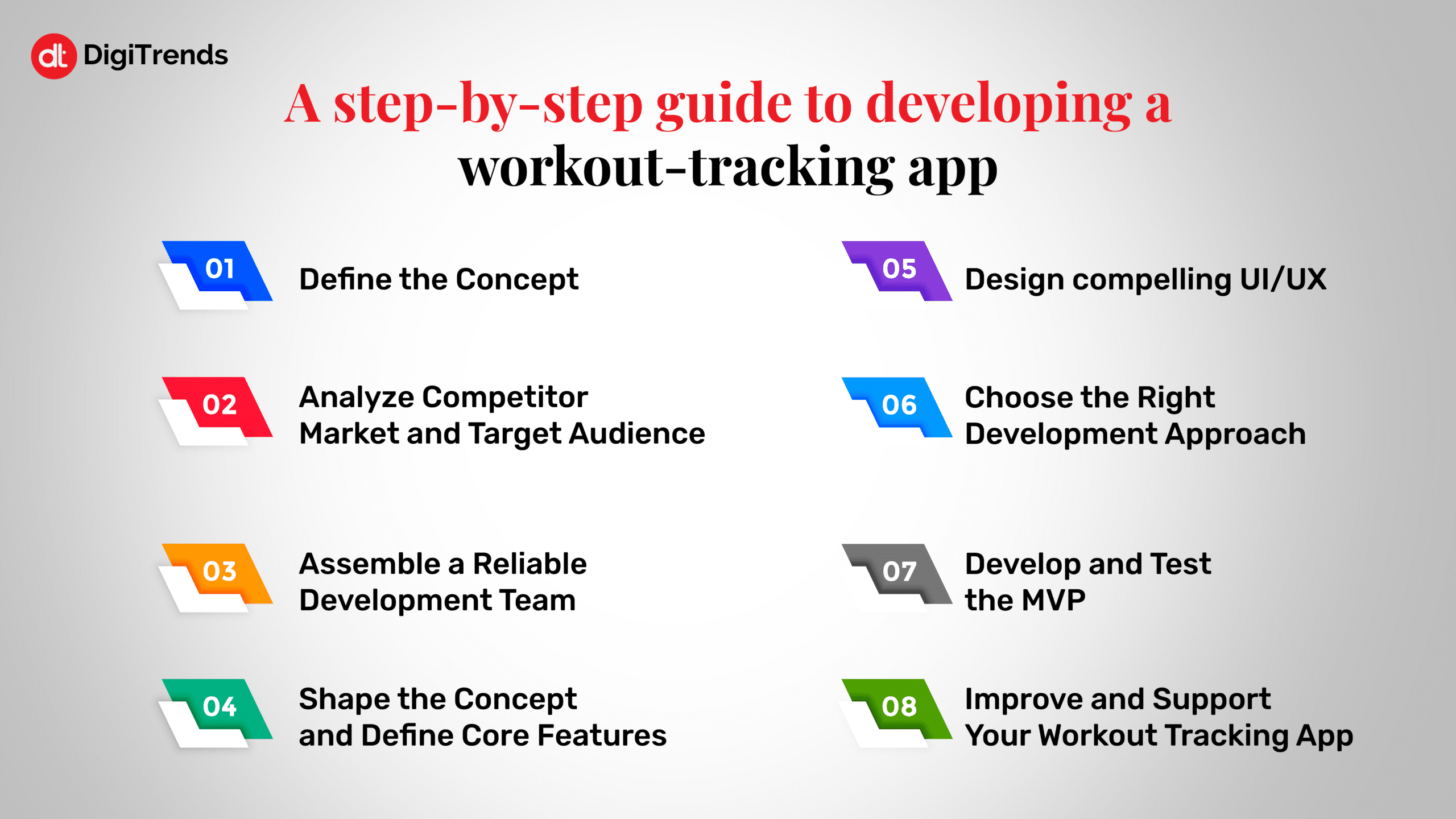
Since it’s not easy to develop a workout tracking app you should first compound your idea of what will be the main purpose of developing this app we are developing an on-demand workout tracking app or just guided meditation because these apps have unique features that also impact the fitness app development process.
Find a burning problem to solve. Find the niche for profitability and skim the niche through top-grossed apps that will help you gain insights and make a better-informed decision.
Before starting firsthand, research is the cornerstone in developing any workout development app. By looking out the other competitors in the fitness tracker app industry and current market trends you have a better understanding of key market player’s core fitness app features, Challenges, and opportunities.
Besides competitors, the second most important thing that counts is your end user. Analyze your competitor’s user base and conduct surveys and interviews to make detailed user personas consisting of their specific needs, problems, and interests. Competitor market and information taken from customer data will ensure that your app is targeting the right audience with the right features.
Having a developer who is skilled in wearable app development and user experience is very important in building a successful workout app. But make your the tech partner you are choosing has a great track record of developing similar apps and projects. If you are unable to make your team of trustworthy developers you can also outsource this whole process. Outsourced development is unmatched in terms of affordability, quality, and hiring speed.
Now you have your team onboard; it’s time to get focus on activity tracking app functionalities like real time monitoring goal setting and analytics Your development team will give their dimension thus enriching projects with new insights.
At this stage, your development team will also complement your initial findings or gatherings. Together, you will solidify your plans and be able to form core app features, user personas, and customer map journeys for the fitness tracker app. This will further shape your value proposition.
Now, the whole research process is transformed into a short brief that summarizes competitor analysis and audience research. This step also outlines the main objective of your solution.
Now your planning stage is done, it’s time to shape the look of your workout tracking app. Based on your market research and collective user personas, your UI/UX developers will design some prototypes and test them with a focus group that will consist of target users.
The prototype is the novel version of your health and fitness app interface it has no code but mimics the user flow of the future solution, The Prototype that gains the most positive feedback will serve as the final draft and will be sent out to the development team for the final layout screen.
Overall your interface design should be highly intuitive and does not contain unnecessary things or screens, like a long log in the process. For example, an app should immediately throw the user in the workout screen and support the flow of users in stages like registration, onboarding, goal setting, and other essential screens.
To turn your product idea into a complete app development like Fitbit, fitness app developers choose the appropriate technology stack during this stage. App requirements, cost expectations, and your company’s level of technological maturity all play a role in the tech stack you choose. The Fitness app development process is planned by the development team which also records all milestones in the following materials.
A minimum viable product (MVP) is your health and fitness app’s initial iteration. Because it only includes the essential app features, you can test your product hypothesis without devoting time and energy to the entire feature set. The QA team verifies your MVP at this stage to make sure it satisfies the technical requirements and is up to initial business standards. To get actual user feedback, developers release your MVP on the App Store or Google Play Store when it’s ready.
Adding nice-to-have features to your MVP is the last step in fitness app development. After the finished solution has been examined for errors and inconsistencies it is made public. You should update and maintain your activity tracking app regularly though to keep the bar high and guarantee long-term success. Your solution will remain in sync with new platform versions, changing user requirements, and fierce competition, if you provide long-term application support. You should also monitor user reviews for bug reports, update ideas, and track the performance of your product using an integrated mobile analytics tool like Firebase or Mixpanel.
Fitness apps are evolving to keep up with the most recent developments in the field. If you’re thinking about making a fitness app in 2025 keep in mind these significant trends.
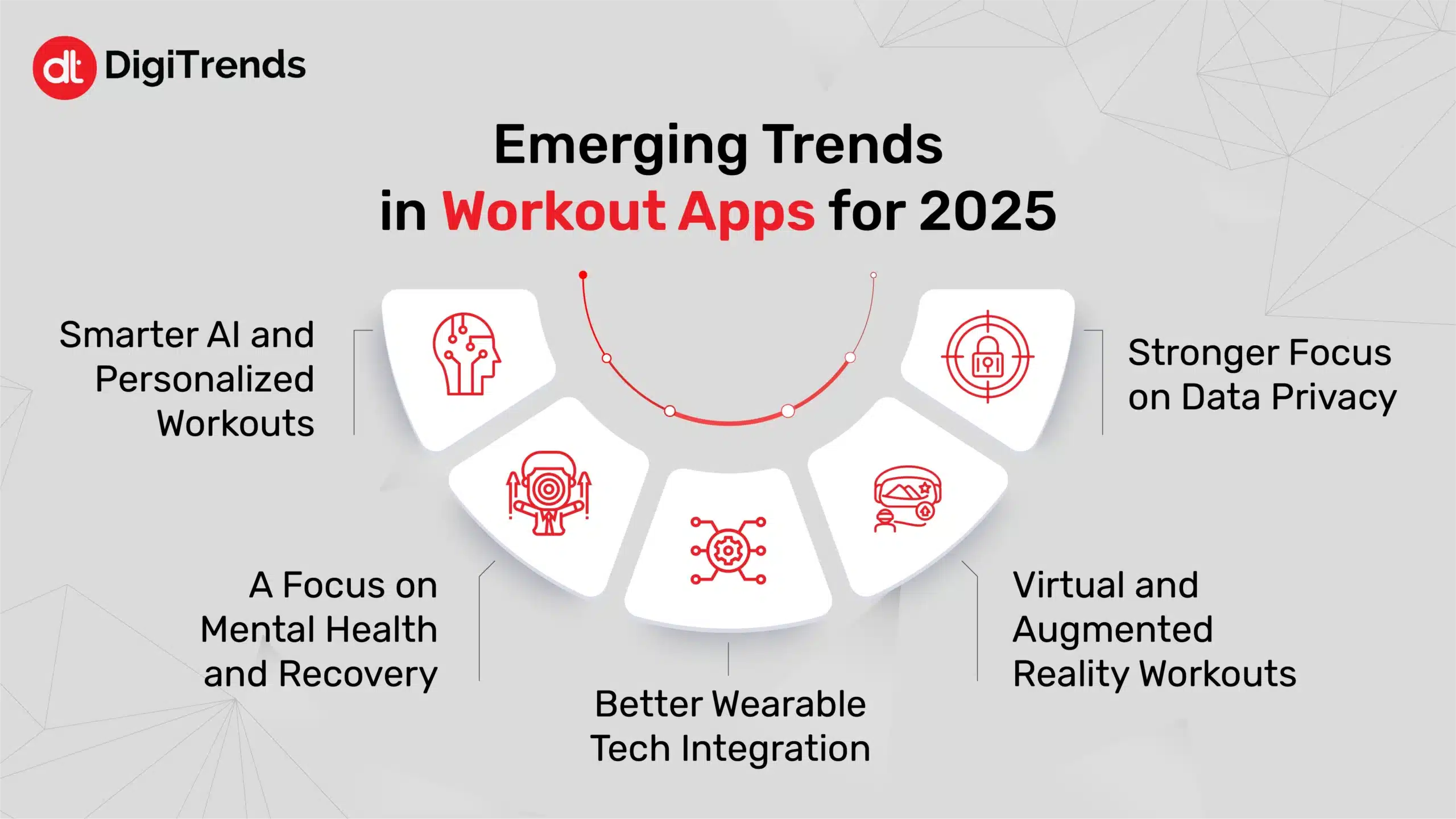
Workout apps are becoming smarter than ever, thanks to artificial intelligence (AI). AI can generate a personalized training plan for each user based on their past workout progress and personal objectives, replacing generic fitness plans. Based on exercise intensity and general health it can also forecast when a user needs to rest and recuperate. Better outcomes and fewer injuries are the outcomes of this.
Virtual trainers driven by AI are also getting better they provide real-time form and technique feedback much like a personal trainer at a gym.
The perfect physique does not entail strenuous activities like weight lifting or long-distance running. Achieving overall mental health wellness is also important. More fitness apps are now integrating stress monitoring, mood recording, and guided meditation to improve a person’s mental state.
Tracking sleep patterns is gaining massive popularity as well. Given that sleep is an important contributor to muscle recuperation and one’s overall health, these applications are now sharing valuable information on the quality of a user’s sleep as well as strategies one can employ to rest better.
Smartwatches and fitness trackers have been around for a while, but 2025 is bringing even better wearable tech. The wearable technology market size is forecast to increase by USD 99.4 billion, at a CAGR of 17.3% between 2025 and 2029. Think smart fabrics that track muscle movement, more compact and accurate sensors, and real-time biometric tracking for things like hydration levels and oxygen intake.
These advancements will allow workout apps to provide even more detailed insights into users’ health and fitness, making workouts more effective and personalized.
VR and AR are making activity tracking apps more immersive and engaging. Working out in virtual reality takes users to new places which adds excitement to fitness. VR adds an immersive element to workouts whether it is running a beautiful mountain trail or taking a virtual spin class.
The use of augmented reality (AR) is also growing. Through AR users can use their smart glasses or phone, cameras to view their real-time form corrections. It is similar to having a coach by your side making sure you are performing exercises properly to prevent injuries.
Security is crucial More than ever because so much personal health data is being gathered. People are concerned about the security of their fitness data and whether it will be shared without their consent. Strong security measures such as encrypted data storage and unambiguous user control over what information they share are essential for developers in light of new privacy regulations. Gaining user’s trust will require being open and honest about data policies.
To make your fitness tracker app profitable, Consider these revenue models.
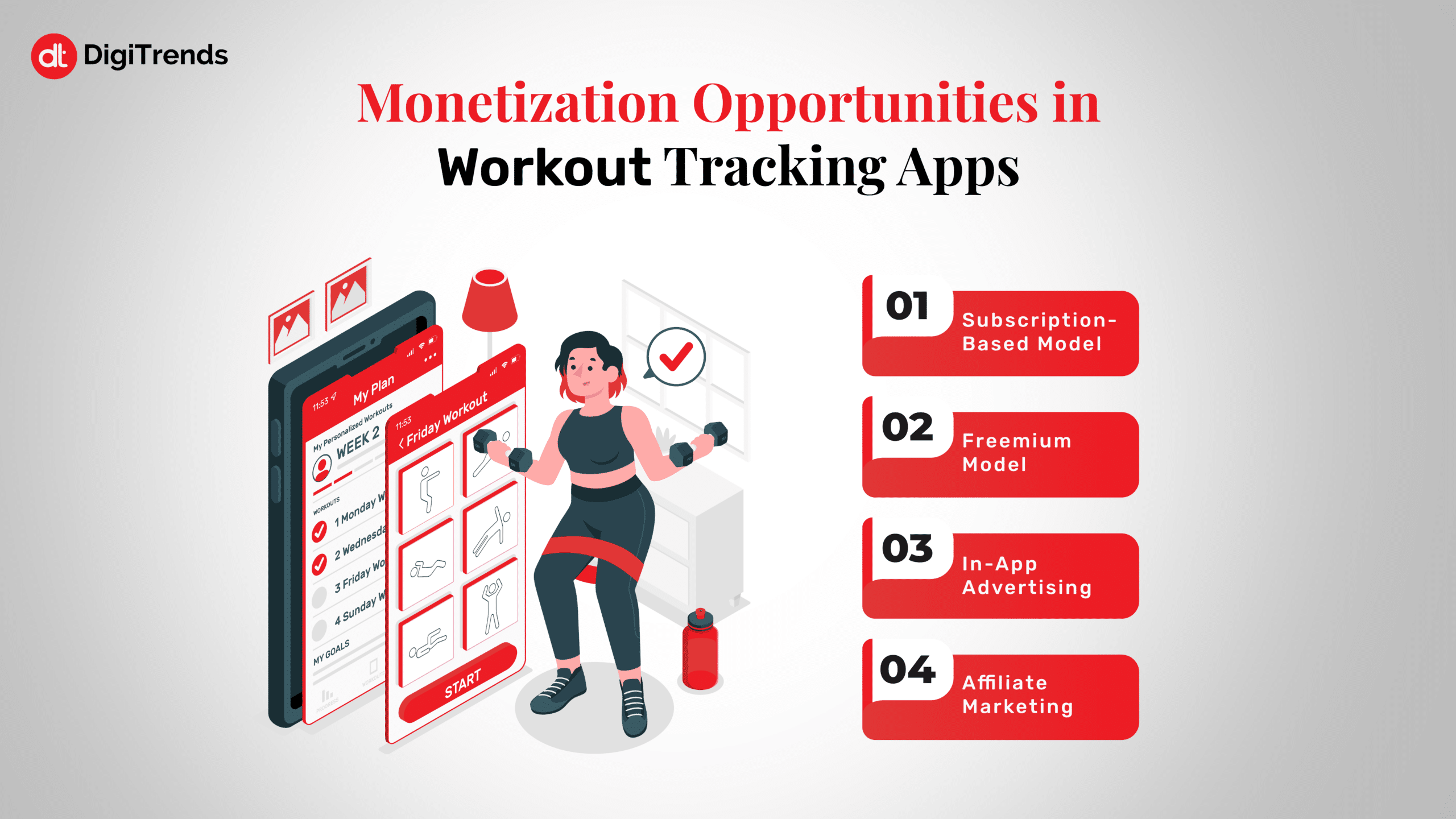
In a subscription-based model, users are charged a recurring fee to access the premium features and content of the app. With this model, you allow users to choose fitness plans according to their preferences. This model is a great option for those fitness apps that offer a lot of different content. The subscription-based model accounts for over 60% of revenue for top fitness apps.
Freemium is the combination of two words: free and premium. It is the most commonly used strategy in fitness apps. In this model, basic features are available for free in workout tracking app; however, to get access to the app’s premium features users need to pay the subscription fee. So app developers can earn high in this way.
In this strategy, advertisements are placed within the app, either in the form of videos, ads, interstitials, or banners. The app companies receive payment from advertisers for the ad placement or promotion of the product. This revenue model can be beneficial if you have a large user base. In this model, you can generate revenue without directly charging the fee from the users.
In affiliate marketing, you can make partnerships with other brands and earn commission by selling third-party services or products. This can become your fitness app’s revenue model, where you form networking with the other brands and help them to get the target audience.
For example, fitness apps like MyFitnessPal partner with companies that sell health and wellness products to offer users exclusive deals and discounts. This model allows app developers to generate revenue while providing users with valuable offers and promotions.
![]()
Workout-tracking apps make fitness easier and more accessible than ever. Advances in AI, virtual reality, and wearable tech have transformed these apps. They now offer personalized workout plans and real-time progress tracking. Gamified features help keep users engaged and motivated. The fitness tracker app market is growing fast. Developers should focus on three main areas i.e., Design that is easy to use. Data privacy and revenue strategies. This will help them to stay competitive. At DigiTrends, we have more than ten years of experience in app development. We have designed amazing mobile apps for clients all over the world. We focus on user-centric design. Also, we use the latest technologies to create a workout-tracking app.
What are the core features of the workout-tracking app?
A successful workout-tracking app should include the following features
What are the steps in developing the workout tracking app?
The development of a workout-tracking app follows these steps.
What are the monetization opportunities of the workout app?
There are various monetization models available for a workout tracking app, some of them are:
What will be the emerging trends in 2025?
The future of workout-tracking apps will be shaped by these trends: